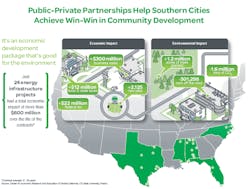Let’s face it. When it comes to energy efficiency, the South seems stuck in its rocking chair on the front porch watching the Northeast and West walk by with all the savings. Time and again, southern states rank among the lowest on national energy efficiency scorecards.
But that’s starting to change. And it has a lot to do with understanding what inspires action on energy in the South, according to Tammy Fulop, Schneider Electric’s vice president of energy and sustainability services.
Fulop reports an uptick in interest among southern schools and municipalities in energy performance contracting. What are the motivators?
- Talk about the Neighbors
Government leaders and school officials are keenly interested in energy efficiency projects undertaken by others locally. If it worked for the neighboring school or city, it’s apt to work for them. It’s not exactly following the Joneses; more like find out what the Joneses are doing and do it even better. So sharing ‘neighbor-to-neighbor’ stories works.
As Fulop puts it, “Once a mayor or superintendent hears what their next door neighbor – or sister city that they have always been in competition with – has been able to achieve with the partnership, they want to learn more.”
Keep up with the latest energy efficiency news. Sign up for Energy Efficiency Market’s free newsletter.
This can provide a kind of second-starter advantage. They study the neighbor’s project and then add to it. For example, a city might include the same lighting and HVAC upgrades to buildings, but enhance them with information technology, security or telecommunications systems that they pay for out of their energy savings.
- Emphasize Economics
Many southern communities are still recovering from the economic downturn. Schools and other public facilities lack the tax revenue to pursue big capital projects. However, boilers, air conditioners and other equipment breaks and must be replaced. Energy performance service contracts (EPSC) allow public facilities to replace equipment with higher efficiency models and pay for them long-term out of the savings.
“It helps them leverage guaranteed future energy savings that can work for them today,” she says
- Improve those Grades
Government rules increasingly demand better energy performance from public buildings. Municipal and school leaders see energy efficiency as a path to compliance. They also want their cities and states to improve their rankings in highly publicized competitions like the American Council for an Energy-Efficient Economy scorecards.
“I’ve seen mayors take greater interest in how the city is perceived on energy and sustainability,” Fulop says. “For them, it’s all about economic development and attracting new business to the city – and providing a nice, livable city for the residents.”
The infographic below offers a by-the-numbers look at some of the energy savings Schneider Electric says it was able to achieve through recent community projects in southern states. Some of the projects, detailed in Schneider Electric case studies, were undertaken in Houston and Denison, Texas; Foley, Alabama; and Madison County Schools, Alabama.






